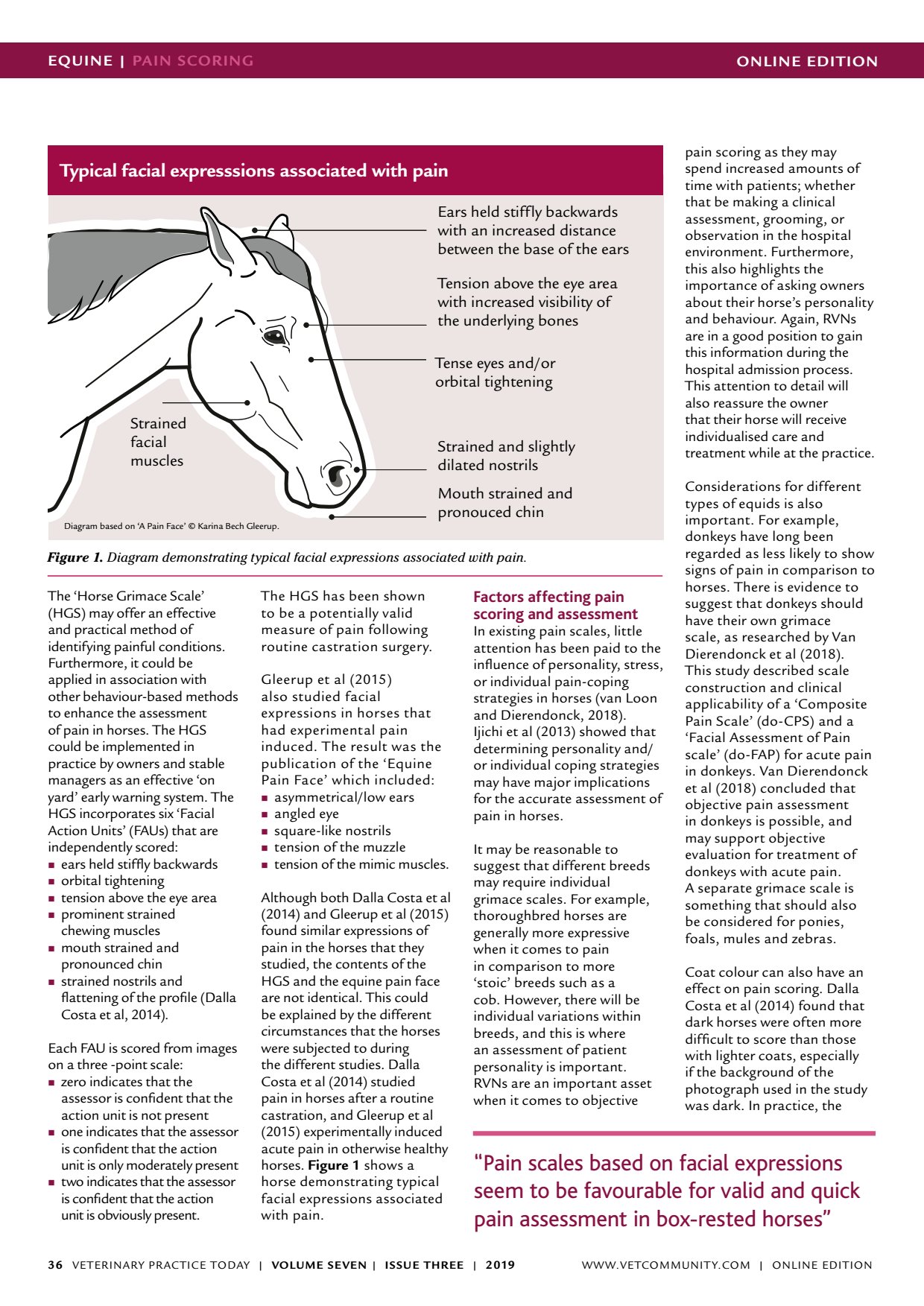Typical facial expresssions
ONLINE EDITIONEQUINE | PAIN SCORING VETERINARY PRACTICE TODAY | VOLUME SEVEN | ISSUE THREE | 2019 36 The Horse Grimace Scale (HGS) may offer an effective and practical method of identifying painful conditions. Furthermore, it could be applied in association with other behaviour-based methods to enhance the assessment of pain in horses. The HGS could be implemented in practice by owners and stable managers as an effective on yard early warning system. The HGS incorporates six Facial Action Units (FAUs) that are independently scored: ears held stiffly backwards orbital tightening tension above the eye area prominent strained chewing muscles mouth strained and pronounced chin strained nostrils and flattening of the profile (Dalla Costa et al, 2014). Each FAU is scored from images on a three -point scale: zero indicates that the assessor is confident that the action unit is not present one indicates that the assessor is confident that the action unit is only moderately present two indicates that the assessor is confident that the action unit is obviously present. The HGS has been shown to be a potentially valid measure of pain following routine castration surgery. Gleerup et al (2015) also studied facial expressions in horses that had experimental pain induced. The result was the publication of the Equine Pain Face which included: asymmetrical/low ears angled eye square-like nostrils tension of the muzzle tension of the mimic muscles. Although both Dalla Costa et al (2014) and Gleerup et al (2015) found similar expressions of pain in the horses that they studied, the contents of the HGS and the equine pain face are not identical. This could be explained by the different circumstances that the horses were subjected to during the different studies. Dalla Costa et al (2014) studied pain in horses after a routine castration, and Gleerup et al (2015) experimentally induced acute pain in otherwise healthy horses. Figure 1 shows a horse demonstrating typical facial expressions associated with pain. Factors affecting pain scoring and assessment In existing pain scales, little attention has been paid to the influence of personality, stress, or individual pain-coping strategies in horses (van Loon and Dierendonck, 2018). Ijichi et al (2013) showed that determining personality and/ or individual coping strategies may have major implications for the accurate assessment of pain in horses. It may be reasonable to suggest that different breeds may require individual grimace scales. For example, thoroughbred horses are generally more expressive when it comes to pain in comparison to more stoic breeds such as a cob. However, there will be individual variations within breeds, and this is where an assessment of patient personality is important. RVNs are an important asset when it comes to objective pain scoring as they may spend increased amounts of time with patients; whether that be making a clinical assessment, grooming, or observation in the hospital environment. Furthermore, this also highlights the importance of asking owners about their horses personality and behaviour. Again, RVNs are in a good position to gain this information during the hospital admission process. This attention to detail will also reassure the owner that their horse will receive individualised care and treatment while at the practice. Considerations for different types of equids is also important. For example, donkeys have long been regarded as less likely to show signs of pain in comparison to horses. There is evidence to suggest that donkeys should have their own grimace scale, as researched by Van Dierendonck et al (2018). This study described scale construction and clinical applicability of a Composite Pain Scale (do-CPS) and a Facial Assessment of Pain scale (do-FAP) for acute pain in donkeys. Van Dierendonck et al (2018) concluded that objective pain assessment in donkeys is possible, and may support objective evaluation for treatment of donkeys with acute pain. A separate grimace scale is something that should also be considered for ponies, foals, mules and zebras. Coat colour can also have an effect on pain scoring. Dalla Costa et al (2014) found that dark horses were often more difficult to score than those with lighter coats, especially if the background of the photograph used in the study was dark. In practice, the Pain scales based on facial expressions seem to be favourable for valid and quick pain assessment in box-rested horses Ears held stiffly backwards with an increased distance between the base of the ears Tension above the eye area with increased visibility of the underlying bones Tense eyes and/or orbital tightening Strained and slightly dilated nostrils Mouth strained and pronouced chin Strained facial muscles Typical facial expresssions associated with pain Diagram based on A Pain Face Karina Bech Gleerup. Figure 1. Diagram demonstrating typical facial expressions associated with pain. WWW.VETCOMMUNIT Y.COM | ONLINE EDITION
